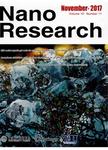Mesoporous TiO2 microparticles formed by the oriented attachment of nanocrystals: A super-durable anode material for sodium-ion batteries
Mesoporous TiO2 microparticles formed by the oriented attachment of nanocrystals: A super-durable anode material for sodium-ion batteries作者机构:Beijing Key Laboratory of Environmental Science and Engineering School of Materials Science and Engineering Beijing Institute of Technology Beijing 100081 China Collaborative Innovation Center of Electric Vehicles in Beijing Beijing 100081 China Beijing Key Laboratory of Construction-Tailorable Advanced Functional Materials and Green Applications School of Materials Science and Engineering Beijing Institute of Technology Beijing 100081 China
出 版 物:《Nano Research》 (纳米研究(英文版))
年 卷 期:2018年第11卷第3期
页 面:1563-1574页
核心收录:
学科分类:0808[工学-电气工程] 0809[工学-电子科学与技术(可授工学、理学学位)] 081705[工学-工业催化] 08[工学] 0817[工学-化学工程与技术] 0805[工学-材料科学与工程(可授工学、理学学位)] 0702[理学-物理学]
主 题:oriented attachment pore evolution mesoporous TiO2 durabilit sodium ion batteries
摘 要:Spindle-shaped anatase TiO2 secondary particles were successfully fabricated via the oriented attachment of primary nanocrystals. By adjusting the concentration of tetrabutyl titanate, the size of the TiO2 nanocrystals and particles could be controlled, resulting in pore evolution. Pores for the random aggregation of secondary particles gradually transformed to nanopores originating from the oriented attachment of the primary nanocrystals, resulting in an excellent micro/nanostructure that increased the performance of a sodium-ion battery. The mesoporous TiO2 microparticle anode, with its unique combination of nanocrystals and uniform nanopores, displays super durability (95 mAh/g after 11,000 cycles at I C), high initial efficiency (61.4%), and excellent rate performance (265 and 77 mAh/g at 0.1 and 20 C, respectively). In particular, at slow discharge (0.1 C) and fast charge (5, 50, and 100 C) rates, the anatase TiO2 shows remarkable initial charge capacities of 200, 119, and 56 mAh/g, corresponding to 172, 127, and 56 mAh/g, after 150 cycles, respectively, thus meeting the requirements for fast energy storage. This excellent performance can be attributed to the stability of the material and its high ionic conductivity, resulting from the stable architecture with a mesoporous microstructure and without the random aggregation of secondary particles. A fundamental understanding of the pore structure and controllable pore construction has been proven to be effective in increasing the rate capability and durability of nanostructured electrode materials.



